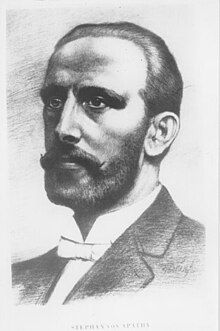István Apáthy
István Apáthy (born January 24, 1863 in Pest , † September 27, 1922 in Szeged ), often known as Stephan Apáthy or Stephan von Apáthy , was a Hungarian physician , biologist , zoologist and politician . His research focus was histology .
Life
Apáthy was the son of the lawyer István Apáthy senior (1829-1889). In 1885 he completed his medical degree. From 1888 to 1890 he was a visiting researcher at the University of Budapest. From 1890 to 1918 he was a professor at the Hungarian Royal University of Kolozsvár (now Cluj-Napoca , Romania ), where he was chairman of the department of zoology and in 1909 founder of what was then the most modern biological institute in Europe. Between 1919 and 1922 he was a professor at the University of Szeged . Apáthys research interests include comparative histology were the nervous system, the neurofilaments and leeches (Hirudinea), of which he several new species described .
Apáthy worked in collaboration with the zoological station in Naples , Italy, doing research partly in Kolozsvár and partly in Naples. Working with the microscope , he developed special experimental methods that aroused worldwide interest, including impregnation with sublimate alcohol, elective staining with gold chloride and double embedding.
In 1897, Apáthy coined the term Neuropil for the first time as part of the nerve network hypothesis . Although this theory was superseded by neuron theory , it, along with Apáthy's research, contributed to a deeper understanding of histology. Apáthy was active in the fields of educational organization and politics. He played an important role in the development of the Kolozsvár University and was its rector between 1903 and 1904. In 1918 he directed the evacuation of the Kolozsvár University to Szeged before Transylvania was occupied by the Romanians. He was also interested in the relationship between biology and sociology and philosophy.
Apáthy's most important writings include The Microtechnology of Animal Morphology I – II (1896–1901), The Conducting Element of the Nervous System and Its Topographical Relationship to the Cells (1897), L'hypothèse de la continuité de M. Apáthy (1908), Magántulajdon , csere és társadalmi élet az állatvilágban (1908), A fejlődés törvénye és a társadalom (1912) and A háború biológiája (1915).
Dedication names
Vidor Tafner described the mite species Chamobates apathyi in 1905 . Lajos Méhelÿ introduced the lizard genus Apathya (with Lacerta cappadocica Werner, 1902 as a type species) in 1907 . The Polish zoologist Michał Gedroyć named the leech species Dina apathyi after Apáthy in 1916.
literature
- Josef Sajner: Stephan Apathy . Dictionary of Scientific Biography . 1. New York: Charles Scribner's Sons, 1970, ISBN 0-684-10114-9 , pp. 176-177.
- Joseph Pungur (Ed.): Hungarian World Encyclopedia Corvin History Society, Edmonton Corvinus Library, Hamilton Canada, 2013, pp. 50–51
| personal data | |
|---|---|
| SURNAME | Apáthy, István |
| ALTERNATIVE NAMES | Apáthy, Stephan; Apáthy, Stephan von |
| BRIEF DESCRIPTION | Hungarian medic, biologist, zoologist and politician |
| DATE OF BIRTH | January 24, 1863 |
| PLACE OF BIRTH | Pest , Kingdom of Hungary |
| DATE OF DEATH | September 27, 1922 |
| Place of death | Szeged , Kingdom of Hungary |
